初一上英语单词词性
- 格式:doc
- 大小:171.50 KB
- 文档页数:8
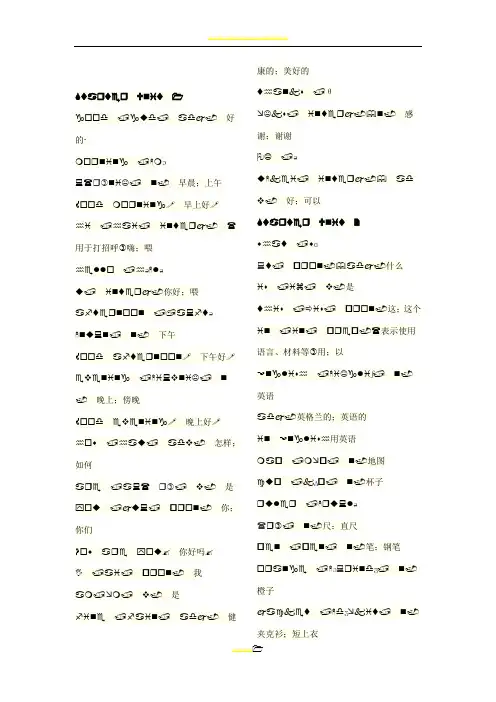
♦♋❒♦♏❒ ✞⏹♓♦ ♑☐☐♎ ♑◆♎ ♋♎ 好的∙❍☐❒⏹♓⏹♑ ❍ɔ☎❒✆⏹♓ ⏹ 早晨;上午☝☐☐♎ ❍☐❒⏹♓⏹♑✐ 早上好✐♒♓ ♒♋♓ ♓⏹♦♏❒ ☎用于打招呼✆嗨;喂♒♏●●☐ ♒ə ●ə◆ ♓⏹♦♏❒你好;喂♋♐♦♏❒⏹☐☐⏹ ♋♐♦ə⏹◆⏹ ⏹ 下午☝☐☐♎ ♋♐♦♏❒⏹☐☐⏹✐ 下午好✐ ♏❖♏⏹♓⏹♑ ♓❖⏹♓ ⏹晚上;傍晚☝☐☐♎ ♏❖♏⏹♓⏹♑✐ 晚上好✐♒☐♦ ♒♋◆ ♋♎❖ 怎样;如何♋❒♏ ♋☎ ❒✆ ❖ 是 ⍓☐◆ ◆ ☐❒☐⏹ 你;你们☟☐♦ ♋❒♏ ⍓☐◆✍ 你好吗✍✋ ♋♓ ☐❒☐⏹ 我♋❍↘❍ ❖ 是♐♓⏹♏ ♐♋♓⏹ ♋♎ 健康的;美好的♦♒♋⏹♦ θ↘ ♦ ♓⏹♦♏❒⏹ 感谢;谢谢 ə◆♏♓ ♓⏹♦♏❒ ♋♎❖ 好;可以♦♋❒♦♏❒ ✞⏹♓♦ ♦♒♋♦ ♦ɑ♦ ☐❒☐⏹♋♎什么♓♦ ♓ ❖是♦♒♓♦ ⇨♓♦ ☐❒☐⏹这;这个 ♓⏹ ♓⏹ ☐❒♏☐☎表示使用语言、材料等✆用;以☜⏹♑●♓♦♒ ♓ ♑●♓ʃ ⏹英语♋♎英格兰的;英语的♓⏹ ☜⏹♑●♓♦♒用英语❍♋☐ ❍↘☐ ⏹地图♍◆☐ ʌ☐ ⏹杯子❒◆●♏❒ ❒◆●ə☎❒✆ ⏹尺;直尺☐♏⏹ ☐♏⏹ ⏹笔;钢笔☐❒♋⏹♑♏ ɔ ❒♓⏹♎ʒ ⏹橙子♋♍♏♦ ♎ʒ↘ ♓♦ ⏹夹克衫;短上衣♏⍓ ♓ ⏹钥匙❑◆♓●♦ ♦♓●♦ ⏹被子;床罩♓♦ ♓♦ ☐❒☐⏹它♋ ə ♋❒♦ ☎用于单数可数名词前 表示未曾提到的✆一☎人、事、物✆♦♒♋♦ ⇨↘♦ ☐❒☐⏹那;那个♦☐♏●● ♦☐♏● ❖用字母拼;拼写☐●♏♋♦♏ ☐●♓ ♓⏹♦♏❒ ☎用于客气地请求或吩咐请✆♦♋❒♦♏❒ ✞⏹♓♦ ♍☐●☐❒ ʌ●ə⏹ ☎♍☐●☐◆❒✆颜色❒♏♎ ❒♏♎ ♋♎ ⏹ 红色(的)⍓♏●●☐♦ ♏●ə◆ ♋♎ ⏹黄色(的) ♑❒♏♏⏹ ♑❒♓⏹ ♋♎ ⏹绿色(的)♌●◆♏ ♌●◆ ♋♎⏹蓝色(的)♌●♋♍ ♌●↘ ♋♎ ⏹黑色(的)♦♒♓♦♏ ♦♋♓♦ ♋♎ ⏹白色(的)☐◆❒☐●♏ ☐ə☐● ♋♎ ⏹紫色(的) ♌❒☐♦⏹ ♌❒♋◆⏹ ♋♎⏹棕色(的);褐色(的)♦♒♏⇨♓⇨ə ♋❒♦指已提到或易领会到的人或事物⏹☐♦ ⏹♋◆ ♋♎❖现在;目前♦♏♏ ♦♓ ❖理解;明白♍♋⏹ ↘⏹ ❍☐♎♋● ❖能;会♦♋⍓ ♦♏♓ ❖说;讲❍⍓ ❍♋♓ ☐❒☐⏹我的✞⏹♓♦ ⏹♋❍♏ ⏹♏♓❍ ⏹名字;名称⏹♓♍♏ ⏹♋♓♦ ♋♎令人愉快的;宜人的♦☐ ♦◆常用于原形动词之前表示该动词为不定式❍♏♏♦ ❍♓♦ ❖遇见;相逢♦☐☐ ♦◆ ♋♎❖也;又;太⍓☐◆❒ ɔ ☐❒☐⏹你的;你们的♦❍♓☎用于女子的姓氏或姓名前 不指明婚否✆女士♒♓♦ ♒♓ ☐❒☐⏹他的♋⏹♎ ↘⏹♎ ♍☐⏹和;又;而♒♏❒ ♒ə ☐❒☐⏹她的⍓♏♦ ♏♦ ♓⏹♦♏❒是的;可以♦♒♏ ʃ♓ ☐❒☐⏹她♒♏ ♒♓ ☐❒☐⏹他⏹☐ ⏹ə◆ ♓⏹♦♏❒不;没有;不是⏹☐♦ ⏹ɑ ♦ ♋♎❖不;没有 ♏❒☐ ♓ə❒ə◆ ⏹◆❍零 ☐⏹♏ ♦ʌ⏹ ⏹◆❍一♦♦☐ ♦◆ ⏹◆❍二♦♒❒♏♏ θ❒♓ ⏹◆❍三 ♐☐◆❒ ♐ɔ ⏹◆❍四♐♓❖♏ ♐♋♓❖ ⏹◆❍五♦♓⌧ ♦♓♦ ⏹◆❍六♦♏❖♏⏹ ♦♏❖⏹ ⏹◆❍七 ♏♓♑♒♦ ♏♓♦ ⏹◆❍八⏹♓⏹♏ ⏹♋♓⏹ ⏹◆❍九♦♏●♏☐♒☐⏹♏ ♦♏●♓♐ə◆⏹ ⏹电话;电话机⏹◆❍♌♏❒ ⏹ʌ❍♌ə ⏹号码;数字☐♒☐⏹♏ ♐ə◆⏹ ⏹电话;电话机♦♏●♏☐♒☐⏹♏☐♒☐⏹♏ ⏹◆❍♌♏❒电话号码♐♓❒♦♦ ♐ə ♦♦ ♋♎第一 ♐♓❒♦♦ ⏹♋❍♏名字●♋♦♦ ●♋♦♦ ♋♎最后的;末尾的●♋♦♦ ⏹♋❍♏姓♐❒♓♏⏹♎ ♐❒♏⏹♎ ⏹朋友♒♓⏹♋ ♦ʃ♋♓⏹ə 中国❍♓♎♎●♏ ❍♓♎● ♋♎中间的;中间♦♍♒☐☐● ♦◆● ⏹学校 ❍♓♎♎●♏ ♦♍♒☐☐●中学;初中✞⏹♓♦ ♦♓♦♦♏❒ ♦♓♦♦ə ⏹姐;妹 ❍☐♦♒♏❒ ❍ʌ⇨ə ⏹母亲;妈妈♐♋♦♒♏❒ ♐♋ ⇨ə ⏹父亲;爸爸☐♋❒♏⏹♦ ☐♏ə❒ə⏹♦ ⏹父(母)亲♌❒☐♦♒♏❒ ♌❒ʌ⇨ə ⏹兄;弟♑❒♋⏹♎❍☐♦♒♏❒♑❒↘⏹❍ʌ⇨ə⏹(外)祖母;奶奶;外婆;姥姥 ♑❒♋⏹♎♐♋♦♒♏❒ ♑❒↘⏹♐♋ ⇨ə ⏹ ☎外✆祖父;爷爷;外公;姥爷♑❒♋⏹♎☐♋❒♏⏹♦♑❒↘⏹ ☐♏ə❒ə⏹♦ ⏹祖父(母);外祖父(母) ♐♋❍♓●⍓ ♐↘❍ə●♓ ⏹家;家庭♦♒☐♦♏ ⇨ə◆ ☐❒☐⏹那些♦♒☐ ♒◆ ☐❒☐⏹谁;什么人☐♒ ə◆ ♓⏹♦♏❒哦;啊 ♦♒♏♦♏ ⇨♓ ☐❒☐⏹这些♦♒♏⍓ ⇨♏♓ ☐❒☐⏹他(她、它)们♦♏●● ♦♏● ♓⏹♦♏❒嗯;好吧♒♋❖♏ ♒↘❖ ❖经受;经历 ☟♋❖♏ ♋ ♑☐☐♎ ♎♋⍓✐ ☎表示祝愿✆过得愉快✐♌⍓♏ ♌♋♓ ♓⏹♦♏❒☎♑☐☐♎♌⍓♏✆再见♦☐⏹ ♦ʌ⏹ ⏹儿子♍☐◆♦♓⏹ʌ ⏹⏹堂兄(弟、姊、妹);表兄(弟、姊、妹)♑❒♋⏹♎☐♋ ♑❒↘⏹☐♋ ⏹(外)祖父;爷爷;外公;姥爷❍☐❍ ❍♋❍ ⏹ ☎❍◆❍✆妈妈♋◆⏹♦ ♋⏹♦ ⏹姑母;姨母;伯母;婶母;舅母♑❒♋⏹♎❍♋ ♑❒↘⏹❍♋ ⏹(外)祖母;奶奶;外婆;姥姥♎♋♎ ♎↘♎ ⏹爸爸◆⏹♍●♏ʌ ●⏹舅父;叔父;伯父;姑父;舅父♎♋◆♑♒♦♏❒ ♎ɔ ♦ə⏹女儿♒♏❒♏♒♓ə ♋♎❖☎用以介绍某人或某物✆这就是;在这里☐♒☐♦☐ ♐ə◆♦ə◆ ⏹照片 ☐♐ ə❖;ʌ❖ ☐❒♏☐属于☎某人或某物✆;关于☎某人或某物✆⏹♏⌧♦⏹♏♦♦♋♎⏹下一个(的);接下来(的)☐♓♍♦◆❒♏ ☐♓♦ʃə ⏹照片;图画♑♓❒● ♑ə ● ⏹女孩♎☐♑ ♎ɔ ♑ ⏹狗✞⏹♓♦ ☐♏⏹♍♓● ☐♏⏹♦● ⏹铅笔♌☐☐ ♌◆ ⏹书♏❒♋♦♏❒ ♓❒♏♓ə ⏹橡皮♌☐⌧ ♌♋♦ ⏹箱;盒 ☐♏⏹♍♓● ♌☐⌧铅笔盒;文具盒♦♍♒☐☐●♌♋♑ ♦◆●♌↘♑⏹书包♎♓♍♦♓☐⏹♋❒⍓ ♎♓⏹❒♓ ⏹词典;字典♒♓♦ ♒♓ ☐❒☐⏹他的❍♓⏹♏ ❍♋♓⏹ ☐❒☐⏹我的♒♏❒♦ ♒ɜ ☐❒☐⏹她的 ♏⌧♍◆♦♏ ♓♦◆ ❖ 原谅;宽恕❍♏ ❍♓ ☐❒☐⏹ ☎✋的宾格✆我♏⌧♍◆♦♏ ❍♏劳驾;请原谅♦♒♋⏹ θ↘ ❖感谢;谢谢♦♏♋♍♒♏❒ ♦♓♦ʃə ⏹老师;教师♋♌☐◆♦ ə♌♋◆♦ ☐❒♏☐关于♒♋♦♋♌☐◆♦✍☎询问消息或提出建议✆怎么样✍…好吗✍⍓☐◆❒♦ ɔ ☐❒☐⏹你的;你们的♐☐❒ ♐ɔ ☐❒♏☐为了;给;对♦♒♋⏹ ⍓☐◆ ♐☐❒为…而感谢♒♏●☐ ♒♏●☐ ❖⏹帮助;援助♦♏●♍☐❍♏ ♦♏●ə❍ ♋♎受欢迎的✡☐◆❒♏ ♦♏●♍☐❍♏别客气 ♌♋♦♏♌♋●● ♌♏♓♦♌ɔ● ⏹棒球♦♋♦♍♒ ♦ʊ♦ʃ ⏹表;手表 ♍☐❍☐◆♦♏❒ ə❍☐◆♦ə ⏹计算机;电脑♑♋❍♏ ♑♏♓❍ ⏹游戏;运动;比赛♍♋❒♎ ɑ ♎ ⏹卡片✋ ♍♋❒♎学生卡;身份证⏹☐♦♏♌☐☐ ⏹ə◆♦♌◆ ⏹笔记本❒♓⏹♑ ❒♓ ⏹戒指♌♋♑ ♌↘♑ ⏹袋;包♓⏹ ♓⏹ ☐❒♏☐在…里●♓♌❒♋❒⍓ ●♋♓♌❒ə❒♓ ⏹图书馆♋♦ ɑ ♦ ❖请求;要求;询问♋♦ ♐☐❒请求;恳求☎给予✆♐♓⏹♎♐♋♓⏹♎❖☎过去式、过去分词♐☐◆⏹♎✆找到;发现♦☐❍♏ ♦ʌ❍ ♋♎一些;某些♍●♋♦♦❒☐☐❍ ●ɑ♦❒◆❍ ⏹教室♏❍♋♓● ♓❍♏♓● ⏹ ☎♏❍♋♓●✆电子邮件♋♦↘♦☐❒♏☐按照;根据;在☎某处、某时间或时刻✆♍♋●● ɔ ● ❖ ☎给✆打电话●☐♦♦ ●ʊ♦♦ ❖ ☎动词●☐♦♏的过去式✆遗失;丢失❍◆♦♦ ❍ʌ♦♦ ❍☐♎♋● ❖必须♦♏♦ ♦♏♦ ⏹一套;一副;一组♋ ♦♏♦ ☐♐一套;一副;一组✞⏹♓♦ ♦♒♏❒♏ ♦♏ə ♋♎❖在哪里;到哪里♦♋♌●♏ ♦♏♓♌● ⏹桌子 ♌♏♎ ♌♏♎ ⏹床 ♌☐☐♍♋♦♏ ♌◆♏♓♦ ⏹书架;书柜♦☐♐♋ ♦ə◆♐ə ⏹沙发♍♒♋♓❒ ♦ʃ♏ə ⏹椅子☐⏹ ʊ⏹ ☐❒♏☐在…上◆⏹♎♏❒ ʌ⏹♎ə ☐❒♏☐在…下♍☐❍♏ ʌ❍ ❖来;来到 ♍☐❍♏ ☐⏹快点儿♎♏♦ ♎♏♦ ⏹书桌♦♒♓⏹ θ♓ ⏹认为;想;思考❒☐☐❍ ❒◆❍ ⏹房间♦♒♏♓❒ ⇨♏ə ☐❒☐⏹他(她、它)们的♒♋♦ ♒↘♦ ⏹帽子♒♏♋♎ ♒♏♎ ⏹头⍓♏♋♒ ♏ə ♓⏹♦♏❒是的;对⏹☐♦ ⏹ə◆ ❖知道;了解 ❒♋♎♓☐ ❒♏♓♎♓ə◆ ⏹收音机;无线电广播♍●☐♍ ●ʊ ⏹时钟 ♦♋☐♏ ♦♏♓☐ ⏹磁带;录音带;录像带☐●♋⍓♏❒ ☐●♏♓ə ⏹播放机♦♋☐♏ ☐●♋⍓♏❒录音机❍☐♎♏● ❍ʊ♎● ⏹模型☐●♋⏹♏ ☐●♏♓⏹ ⏹飞机 ❍☐♎♏● ☐●♋⏹♏飞机模型♦♓♎⍓ ♦♋♓♎♓ ♋♎整洁的;井井有条的♌◆♦ ♌ʌ♦ ♍☐⏹但是☐◆❒ ♋◆ə ☐❒☐⏹我们的 ♏❖♏❒⍓♦♒♏❒♏ ♏❖❒♓♦♏ə♋♎❖处处;到处;各个地方♋●♦♋⍓♦ ɔ●♦♏♓ ♋♎❖总是✞⏹♓♦ ♎☐♎◆♋◆⌧❖❖用于构成否定句和疑问句;做;干♒♋❖♏ ♒↘❖ ❖有♦♏⏹⏹♓♦ ♦♏⏹♓♦ ⏹网球 ♌♋●● ♌ɔ ● ⏹球☐♓⏹♑☐☐⏹♑ ☐♓☐ʊ ⏹乒乓球♌♋♦ ♌↘♦ ⏹球棒;球拍 ♦☐♍♍♏❒ ♦ʊ ə ⏹(英式)足球♦☐♍♍♏❒ ♌♋●● ☎英式✆足球❖☐●●♏⍓♌♋●● ❖ʊ●♓♌ɔ● ⏹排球♌♋♦♏♦♌♋●● ♌♋♦♓♦♌ɔ ● ⏹篮球♒♏⍓ ♒♏♓ ♓⏹♦♏❒嘿;喂●♏♦ ●♏♦ ❖允许;让◆♦ ʌ♦ ☐❒☐⏹ ☎♦♏的宾格✆我们●♏♦♦ ●♏♦ ◆♦让我们(一起) ♑☐ ♑ə◆ ❖去;走♦♏ ♦♓ ☐❒☐⏹我们●♋♦♏ ●♏♓♦ ♋♎迟到 ♒♋♦ ♒↘ ❖ ☎♒♋❖♏的第三人称单数形式✆有♑♏♦ ♑♏♦ ❖去取(或带来);得到♑❒♏♋♦ ♑❒♏♓♦ ♋♎美妙的;伟大的☐●♋⍓ ☐●♏♓ ❖参加(比赛或运动);玩耍♦☐◆⏹♎ ♦♋◆⏹♎ ❖听起来好像♓⏹♦♏❒♏♦♦♓⏹♑ ♓⏹♦❒ə♦♦♓ ♋♎有趣的♌☐❒♓⏹♑ ♌ɔ❒♓ ♋♎没趣的;令人厌倦的♐◆⏹ ♐ʌ⏹ ♋♎有趣的;使人快乐的⏹乐趣;快乐♎♓♐♐♓♍◆●♦ ♎♓♐♓ə●♦ ♋♎困难的❒♏●♋⌧♓⏹♑ ❒♓●↘♦♓♋♎轻松的;令人放松的♦♋♦♍♒ ♦ʊ♦ʃ ❖注视;观看 ❆✞ ♦♓❖♓ ⏹ ☎♦♏●♏❖♓♦♓☐⏹✆电视;电视机♦♋♦♍♒ ❆✞看电视♦♋❍♏ ♦♏♓❍ ♋♎相同的●☐❖♏ ●ʌ❖ ❖⏹爱;喜爱♦♓♦♒ ♦♓⇨ ☐❒♏☐和…在一起;带有;使用♦☐☐❒♦ ♦☐ɔ ♦ ⏹体育运动 ♦♒♏❍ ⇨♏❍ ☐❒☐⏹ ☎♦♒♏⍓的宾格✆他☎她、它✆们☐⏹●⍓ ə◆⏹●♓ ♋♎❖只;仅●♓♏ ●♋♓ ❖喜欢;喜爱♏♋♦⍓ ♓♓ ♋♎容易的;不费力的♋♐♦♏❒ ♋♐♦ə☐❒♏☐在…以后♍●♋♦♦ ●♋♦ ⏹班级;课 ♍●♋♦♦❍♋♦♏ ●♋♦❍♏♓♦ ⏹同班同学✞⏹♓♦ ♌♋⏹♋⏹♋ ♌ə ⏹♋⏹ə ⏹香蕉♒♋❍♌◆❒♑♏❒ ♒↘❍♌ɜ ♑ə ⏹汉堡包♦☐❍♋♦☐ ♦ə ❍♋♦ə◆ ⏹西红柿♓♍♏♍❒♏♋❍ ♋♓♦❒♓❍ ⏹冰激凌♦♋●♋♎ ♦↘●ə♎ ⏹沙拉♦♦❒♋♦♌♏❒❒⍓ ♦♦❒ɔ ♌ə❒♓ ⏹草莓☐♏♋❒ ☐♏ə ⏹梨❍♓● ❍♓● ⏹牛奶♌❒♏♋♎ ♌❒♏♎ ⏹面包 ♌♓❒♦♒♎♋⍓ ♌ɜ θ♎♋♓ ⏹生日♎♓⏹⏹♏❒ ♎♓⏹ə ⏹ ☎中午或晚上吃的✆正餐♦♏♏ ♦♓ ⏹周;星期 ♦♒♓⏹ ♋♌☐◆♦思考;思索♐☐☐♎ ♐◆♎ ⏹食物♦◆❒♏ ʃ◆ə ♋♎❖当然;肯定;一定☟☐♦ ♋♌☐◆♦✍ ☎提出建议✆…怎么样✍♌◆❒♑♏❒ ♌ɜ ♑ə⏹ ☎♒♋❍♌◆❒♑♏❒✆汉堡包❖♏♑♏♦♋♌●♏ ❖♏♎ʒ♦ə♌● ⏹蔬菜♐❒◆♓♦ ♐❒◆♦ ⏹水果 ❒♓♑♒♦ ❒♋♓♦ ♋♎正确的;适当的♋☐☐●♏ ↘☐● ⏹苹果♦♒♏⏹ ⇨♏⏹ ♋♎❖那么♏♑♑ ♏♑ ⏹蛋;鸡蛋♍♋❒❒☐♦ ↘❒ə♦ ⏹胡萝卜❒♓♍♏ ❒♋♓♦ ⏹大米;米饭 ♍♒♓♍♏⏹ ♦ʃ♓♓⏹ ⏹鸡肉♦☐ ♦ə◆ ♍☐⏹ ☎引出评论或问题✆那么♌❒♏♋♐♋♦♦ ♌❒♏♐ə♦♦ ⏹早餐;早饭●◆⏹♍♒ ●ʌ⏹♦ʃ ⏹午餐♦♦♋❒ ♦♦♋ ⏹明星;星星 ♏♋♦ ♓♦ ❖吃♦♏●● ♦♏● ♋♎❖好;令人满意地♒♋♌♓♦ ♒↘♌♓♦ ⏹习惯 ♒♏♋●♦♒⍓ ♒♏●θ♓ ♋♎健康的❒♏♋●●⍓ ❒♓ə●♓ ♋♎❖真正地❑◆♏♦♦♓☐⏹ ♦♏♦♦ʃə⏹ ⏹问题♦♋⏹♦ ♦ɒ⏹♦ ❖需要;想要 ♌♏ ♌♓ ❖变成♐♋♦ ♐↘♦ ♋♎肥的;肥胖的✞⏹♓♦ ❍◆♍♒ ❍ʌ♦ʃ ☐❒☐⏹♋♎许多;大量;多少☟☐♦ ❍◆♍♒✍ ☎购物时✆…多少钱✍♦☐♍ ♦ɒ ⏹短袜❆♦♒♓❒♦ ♦♓ʃɜ ♦ ⏹ ❆恤衫♦♒☐❒♦♦ ʃɔ ♦♦ ⏹ ☎☐●✆短裤♦♦♏♋♦♏❒ ♦♦♏♦ə ⏹毛衣 ♦❒☐◆♦♏❒♦ ♦❒♋◆ə ⏹ ☎☐●✆裤子♦♒☐♏ ʃ◆ ⏹鞋♦♓❒♦ ♦ɜ ♦ ⏹裙子♎☐●●♋❒ ♎ɒ●ə ⏹元☎美国、加拿大等国的货币单位 符号为 ✆ ♌♓♑ ♌♓♑ ♋♎大的;大号的♦❍♋●● ♦❍ɔ ● ♋♎小的;小号的♦♒☐❒♦ ʃɔ ♦ ♋♎短的;矮的●☐⏹♑ ●ɔ ♋♎长的♦☐❍♋⏹ ♦◆❍ə⏹ ⏹女子♋⏹ ✋ ♒♏●☐ ⍓☐◆✍我能帮您吗✍⏹♏♏♎ ⏹♓♎ ❖需要●☐☐ ●◆ ❖看;看上去 ☐♋♓❒ ☐♏ə ⏹一双;一对 ♦♋♏ ♦♏♓ ❖买下;拿;取☟♏❒♏ ⍓☐◆ ♋❒♏给你♦♏⏹ ♦♏⏹ ⏹◆❍十♏●♏❖♏⏹ ♓●♏❖ə⏹ ⏹◆❍十一♦♦♏●❖♏ ♦♦♏●❖ ⏹◆❍十二♦♒♓❒♦♏♏⏹ θɜ ♦♓⏹ ⏹◆❍十三♐♓♐♦♏♏⏹ ♐♓♐♦♓⏹ ⏹◆❍十五 ♏♓♑♒♦♏♏⏹ ♏♓♦♓⏹ ⏹◆❍十八♦♦♏⏹♦⍓ ♦♦♏⏹♦♓ ⏹◆❍二十♦♒♓❒♦⍓ θɜ ♦♓ ⏹◆❍三十❒ ❍♓♦♦ə 先生♍●☐♦♒♏♦ ●ə◆⇨ ⏹ ☎☐●✆衣服;服装 ♦♦☐❒♏ ♦♦ɔ ⏹商店♌◆⍓ ♌♋♓ ❖购买;买♦♋●♏ ♦♏♓● ⏹特价销售;出售♦♏●● ♦♏● ❖出售;销售;卖♋●● ɔ ● ♋♎所有的;全部的❖♏❒⍓ ❖♏❒♓ ♋♎❖很;非常☐❒♓♍♏ ☐❒♋♓♦ ⏹价格 ♌☐⍓ ♌ɔ♓ ⏹男孩♋ ☐♋♓❒ ☐♐一双✞⏹♓♦ ♦♒♏⏹ ♦♏⏹ ♋♎❖ ☎疑问副词✆什么时候❍☐⏹♦♒ ❍ʌ⏹θ ⏹月;月份 ☺♋⏹◆♋❒⍓ ♎ʒə⏹◆ə❒♓ ⏹一月☞♏♌❒◆♋❒⍓ ♐♏♌❒◆ə❒♓ ⏹二月♋❒♍♒ ❍♋♦ʃ ⏹三月 ✌☐❒♓● ♏♓☐❒ə● ⏹四月 ♋⍓ ❍♏♓ ⏹五月☺◆⏹♏ ♎ʒ◆⏹ ⏹六月☺◆●⍓ ♎ʒ◆●♋♓ ⏹七月 ✌◆♑◆♦♦ ɔ ♑ə♦♦ ⏹八月 ♏☐♦♏❍♌♏❒ ♦♏☐♦♏❍♌ə ⏹九月♍♦☐♌♏❒ ɒ ♦ə◆♌ə ⏹十月☠☐❖♏❍♌♏❒ ⏹ə◆❖♏❍♌ə ⏹十一月♏♍♏❍♌♏❒ ♎♓♦♏❍♌ə ⏹十二月♒♋☐☐⍓ ♒↘☐♓ ♋♎愉快的;高兴的☟♋☐☐⍓ ♌♓❒♦♒♎♋⍓✐生日快乐✐☐●♎ ə◆●♎ ♋♎年老的;旧的☟☐♦ ☐●♎✍ 多大年纪✍…几岁了✍☐♋❒♦⍓ ☐♋♦♓ ⏹聚会;晚会 ♏♏ ⍓☐◆✐再见✐♐♓❒♦♦ ♐ɜ ♦♦ ⏹◆❍第一 ♦♏♍☐⏹♎ ♦♏ə⏹♎ ⏹◆❍第二♦♒♓❒♎ θɜ ♎ ⏹◆❍第三 ♐♓♐♦♒ ♐♓♐θ ⏹◆❍第五♏♓♑♒♦♒ ♏♓♦θ ⏹◆❍第八⏹♓⏹♦♒ ⏹♋♓⏹θ ⏹◆❍第九♦♦♏●♐♦♒ ♦♦♏●♐θ ⏹◆❍第十二♦♦♏⏹♦♓♏♦♒ ♦♦♏⏹♦♓əθ ⏹◆❍第二十♦♏♦♦ ♦♏♦♦ ⏹测验;检查 ♦❒♓☐ ♦❒♓☐ ⏹旅游;旅行 ♋❒♦ ♋♦ ⏹艺术;美术 ♐♏♦♦♓❖♋● ♐♏♦♦♓❖● ⏹☎音乐、戏剧等的✆会演节;节日♎♏♋❒ ♎♓ə ♋♎亲爱的 ♦♦◆♎♏⏹♦ ♦♦◆♎⏹♦ ⏹学生♦♒♓⏹♑ θ♓ ⏹东西;事情♦♏❒❍ ♦ɜ ❍ ⏹学期♌◆♦⍓ ♌♓♓ ♋♎忙碌的;无暇的♦♓❍♏ ♦♋♓❍ ⏹时间☟♋❖♏ ♋ ♑☐☐♎ ♦♓❍♏✐ ☎表示祝愿✆过得愉快✐♦♒♏❒♏ ⇨♏ə ♋♎❖ ☎在✆那里✞⏹♓♦ ♐♋❖☐❒♓♦♏♐♏♓❖ə❒♓♦♋♎⏹☎♐♋❖☐◆❒♓♦♏✆特别喜爱的☎人或事物✆♦◆♌♏♍♦ ♦ʌ♌♎ʒɪ ♦ ⏹学科;科目♦♍♓♏⏹♍♏ ♦♋♓ə⏹♦ ⏹科学☜ ☐♓ ♓ ⏹☎☐♒⍓♦♓♍♋● ♏♎◆♍♋♦♓☐⏹✆体育❍◆♦♓♍ ❍◆♓ ⏹音乐;乐曲❍♋♦♒ ❍↘θ ⏹数学♒♓⏹♏♦♏ ♦ʃ♋♓⏹♓ ⏹语文;汉语♋♎汉语;中国的♑♏☐♑❒♋☐♒⍓ ♎ʒ♓ɒ♑❒ə♐♓ ⏹地理☎学✆♒♓♦♦☐❒⍓ ♒♓♦♦❒♓ ⏹历史♦♒⍓ ♦♋♓ ♋♎❖为什么 ♌♏♍♋◆♦♏ ♌♓ɒ ♍☐⏹因为☐⏹♎♋⍓ ❍ʌ⏹♎♏♓ ⏹星期一☞❒♓♎♋⍓ ♐❒♋♓♎♏♓ ⏹ 星期五♋♦◆❒♎♋⍓ ♦↘♦ə♎♏♓ ⏹星期六♐☐❒ ♦◆❒♏无疑;肯定♐❒♏♏ ♐❒♓ ♋♎空闲的 ♍☐☐● ◆● ♋♎妙极的;酷的❆◆♏♦♎♋⍓ ♦◆♎♏♓ ⏹星期二♏♎⏹♏♦♎♋⍓ ♦♏⏹♎♏♓ ⏹星期三❆♒◆❒♦♎♋⍓ θɜ ♎♏♓ ⏹星期四◆⏹♎♋⍓ ♦ʌ⏹♎♏♓ ⏹星期日✌ ♏♓ ♏❍ ☎♋ ❍上午 ☐♓ ♏❍ ☎☐❍✆下午;午后◆♦♏♐◆● ◆♦♐● ♋♎ 有用的;有益的♐❒☐❍♐❒ɒ❍☐❒♏☐☎表示开始的时间✆从…开始♐❒☐❍ ♦☐从…到…❒♦❍♓♦♓☎用于女子的姓氏或姓名前✆太太;夫人♐♓⏹♓♦♒ ♐♓⏹♓ʃ ❖完成;做好●♏♦♦☐⏹ ●♏♦⏹ ⏹课;一节课♒☐◆❒ ♋◆ə ⏹小时。
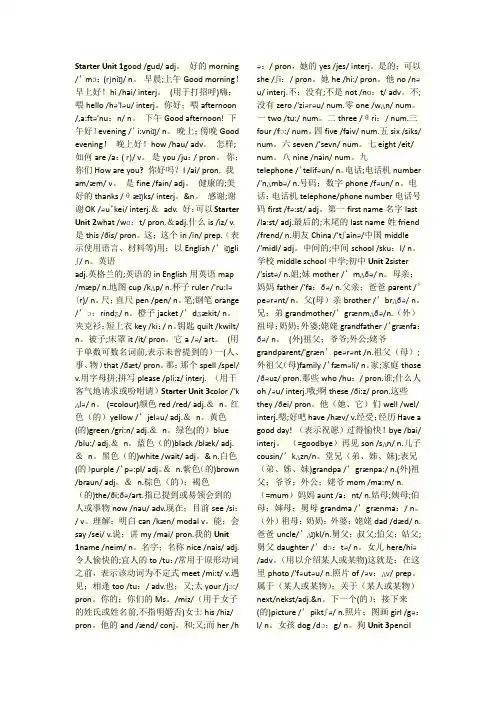
Starter Unit 1good /gud/ adj。
好的morning /’mɔ:(r)niŋ/ n。
早晨;上午Good morning!早上好!hi /hai/ interj。
(用于打招呼)嗨;喂hello /hə'ləu/ interj。
你好;喂afternoon /,a:ftə'nu:n/ n。
下午Good afternoon! 下午好!evening /’i:vniŋ/ n。
晚上;傍晚Good evening!晚上好!how /hau/ adv。
怎样;如何are /a:( r)/ v。
是you /ju:/ pron。
你;你们How are you? 你好吗?I /ai/ pron. 我am/æm/ v。
是fine /fain/ adj。
健康的;美好的thanks /θæŋks/ interj。
&n。
感谢;谢谢OK /əu’kei/ interj.&adv. 好;可以Starter Unit 2what /wɑ:t/ pron.&adj.什么is /iz/ v.是this /ðis/ pron。
这;这个in /in/ prep.(表示使用语言、材料等)用;以English /’iŋgli ʃ/ n。
英语adj.英格兰的;英语的in English用英语map /mæp/ n.地图cup /kʌp/ n.杯子ruler /'ru:lə(r)/ n。
尺;直尺pen /pen/ n。
笔;钢笔orange /’ɔ:rindʒ/ n。
橙子jacket /’dʒækit/ n。
夹克衫;短上衣key /ki:/ n。
钥匙quilt /kwilt/ n。
被子;床罩it /it/ pron。
它a /ə/ art。
(用于单数可数名词前,表示未曾提到的)一(人、事、物)that /ðæt/ pron。
那;那个spell /spel/ v.用字母拼;拼写please /pli:z/ interj. (用于客气地请求或吩咐请)Starter Unit 3color /'k ʌlə/ n。
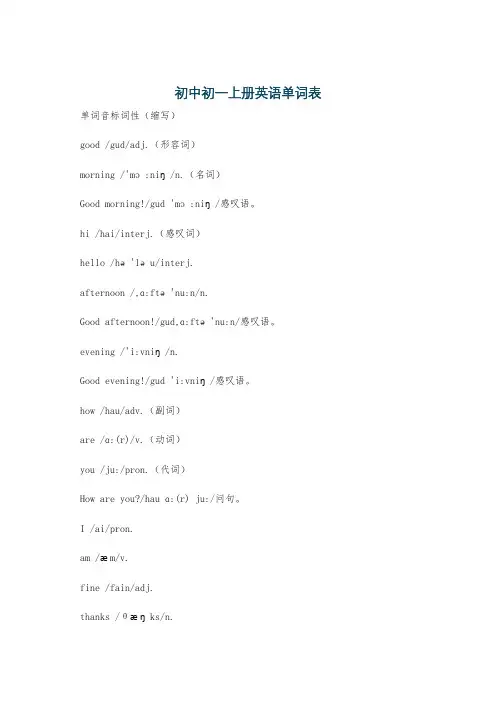
初中初一上册英语单词表单词音标词性(缩写)good /gud/adj.(形容词)morning /'mɔ:niŋ/n.(名词)Good morning!/gud 'mɔ:niŋ/感叹语。
hi /hai/interj.(感叹词)hello /hə'ləu/interj.afternoon /,ɑ:ftə'nu:n/n.Good afternoon!/gud,ɑ:ftə'nu:n/感叹语。
evening /'i:vniŋ/n.Good evening!/gud 'i:vniŋ/感叹语。
how /hau/adv.(副词)are /ɑ:(r)/v.(动词)you /ju:/pron.(代词)How are you?/hau ɑ:(r) ju:/问句。
I /ai/pron.am /æm/v.fine /fain/adj.thanks /θæŋks/n.OK /əu'kei/interj.what /wɔt/pron.is /iz/v.this /ðis/pron.in /in/prep.(介词)English /'iŋgliʃ/n. / adj.map /mæp/n.cup /kʌp/n.ruler /'ru:lə/n.pen /pen/n.orange /'ɔrindʒ/n. / adj.jacket /'dʒækɪt/n.key /ki:/n.quilt /kwilt/n.it /it/pron.a /ei; ə/art.(冠词)that /ðæt/pron.spell /spel/v.please /pli:z/interj.color /'kʌlə/n.(美式英语,英式为colour)red /red/adj. / n.yellow /'jeləu/adj. / n.green /gri:n/adj. / n.blue /blu:/adj. / n.black /blæk/adj. / n.white /wait/adj. / n.purple /'pə:pl/adj. / n.brown /braun/adj. / n.the /ðə; ði:; θi:; θə/art. and /ænd/conj.(连词)my /mai/pron.name /neim/n.nice /nais/adj.to /tu:; tə; tu/prep.meet /mi:t/v.too /tu:/adv.your /jɔ:(r)/pron.his /hiz/pron.her /hə:(r)/pron.yes /jes/interj.no /nəu/interj.not /nɔt/adv.zero /'ziərəu/num.(数词)one /wʌn/num.two /tu:/num.three /θri:/num.four /fɔ:(r)/num.five /faiv/num.six /siks/num.seven /'sevn/num.eight /eit/num.nine /nain/num.telephone /'telifəun/n.number /'nʌmbə(r)/n.phone /fəun/n.(等于telephone,常简写成phone)it's /its/(it is的缩写形式)first /fə:st/num. / adj. / adv.last /lɑ:st/adj. / v. / n. / adv.friend /frend/n.China /'tʃainə/n.middle /'midl/adj. / n.school /sku:l/n.middle school/midl sku:l/n.(中学)。
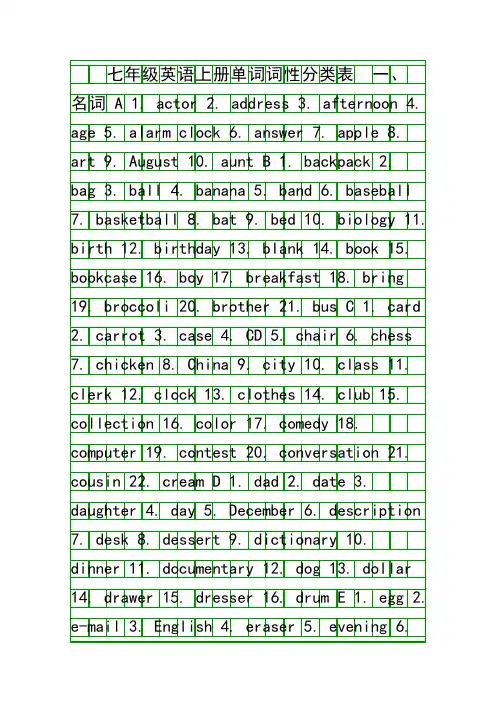
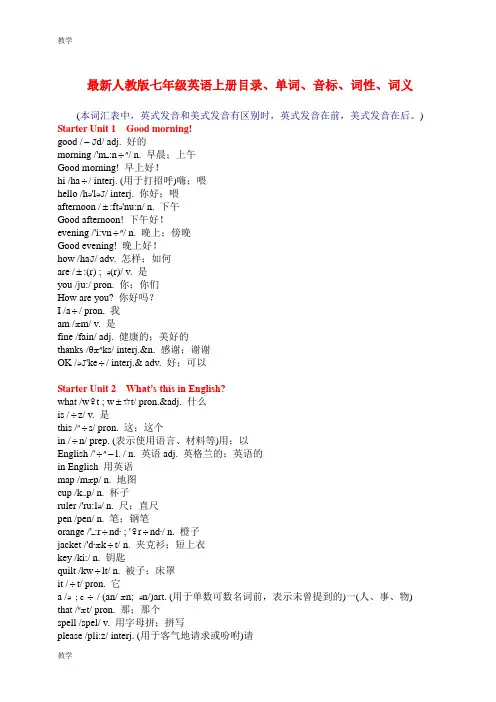
最新人教版七年级英语上册目录、单词、音标、词性、词义(本词汇表中,英式发音和美式发音有区别时,英式发音在前,美式发音在后。
) Starter Unit 1 Good morning!good / J d/ adj. 好的morning /'m :n / n. 早晨;上午Good morning! 早上好!hi /ha / interj. (用于打招呼)嗨;喂hello /hə'ləJ/ interj. 你好;喂afternoon / :ftə'nu:n/ n. 下午Good afternoon! 下午好!evening /'i:vn / n. 晚上;傍晚Good evening! 晚上好!how /ha J/ adv. 怎样;如何are / :(r) ; ə(r)/ v. 是you /ju:/ pron. 你;你们How are you? 你好吗?I /a / pron. 我am /æm/ v. 是fine /fain/ adj. 健康的;美好的thanks /θæ ks/ interj.&n. 感谢;谢谢OK /əJ'ke / interj.& adv. 好;可以Starter Unit 2 What’s this in English?what /w t ; w t/ pron.&adj. 什么is / z/ v. 是this / s/ pron. 这;这个in / n/ prep. (表示使用语言、材料等)用;以English /' l / n. 英语adj. 英格兰的;英语的in English 用英语map /mæp/ n. 地图cup /k p/ n. 杯子ruler /'ru:lə/ n. 尺;直尺pen /pen/ n. 笔;钢笔orange /' :r nd ; ' r nd / n. 橙子jacket /'d æk t/ n. 夹克衫;短上衣key /ki:/ n. 钥匙quilt /kw lt/ n. 被子;床罩it / t/ pron. 它a /ə; e / (an/ æn; ən/)art. (用于单数可数名词前,表示未曾提到的)一(人、事、物) that / æt/ pron. 那;那个spell /spel/ v. 用字母拼;拼写please /pli:z/ interj. (用于客气地请求或吩咐)请Starter Unit 3 What color is it?color /'k lə/ n. (=colour) 颜色red /red/ adj.& n. 红色(的)yellow /'jeləJ/ adj.& n. 黄色(的)green / ri:n/ adj.& n. 绿色(的)blue /blu:/ adj.& n. 蓝色(的)black /blæk/ adj.& n. 黑色(的)white /wa t/ adj.& n. 白色(的)purple /'p3:pl/ adj.& n. 紫色(的)brown /bra J n/ adj.& n. 棕色(的);褐色(的)the / ; ə/ art. 指已提到或易领会到的人或事物now /na J/ adv. 现在;目前see /si:/ v. 理解;明白can /kæn;kən/ modal v. 能;会say /se / v. 说;讲my /ma / pron. 我的Unit 1 My name’s Gina.name /ne m/ n. 名字;名称nice /na s/ adj. 令人愉快的;宜人的to /tu:tə/常用于原形动词之前,表示该动词为不定式meet /mi:t/ v. 遇见;相逢too /tu:/ adv. 也;又;太your /j :/ pron. 你的;你们的Ms. /m z/ (用于女子的姓氏或姓名前,不指明婚否)女士his /h z/ pron. 他的and /ænd ; ənd/ conj. 和;又;而her /h3:(r)/ pron, 她的yes /jes/ interj. 是的;可以she / i:/ pron. 她he /hi:/ pron. 他no /nəJ/ interj. 不;没有;不是not /n t ; n t/ adv. 不;没有zero /'z ərəJ ; 'z rəJ/ num. 零one /w n/ num. 一two /tu:/ num. 二three /θri:/ num. 三four /f :/ num. 四five /fa v/ num. 五six /s ks/ num. 六seven /'sevn/ num. 七eight /e t/ num. 八nine /na n/ num. 九telephone /'tel fəJ n/ n. 电话;电话机number /'n mbə/ n. 号码;数字phone /fəJ n/ n. 电话;电话机telephone/phone number 电话号码first /f3:st/ adj. 第一first name 名字last /l :st ; læst/ adj. 最后的;末尾的last name 姓friend /frend/ n. 朋友China /'t a nə/ 中国middle /'m dl/ adj. 中间的;中间school /sku:l/ n. 学校middle school 中学;初中Unit 2 This is my sister.sister /'s stə/ n. 姐;妹mother /'m ə/ n. 母亲;妈妈father /'fa: ə/ n. 父亲;爸爸parent /'peərənt/ n. 父(母)亲brother /'br ə/ n. 兄;弟grandmother /' rænm ə/ n. (外)祖母;奶奶;外婆;姥姥grandfather /' rænf : ə/ n. (外)祖父;爷爷;外公;姥爷grandparent /' rænpeərənt/ n. 祖父(母);外祖父(母)family /'fæməli/ n. 家;家庭those / əJ z/ pron. 那些who /hu:/ pron. 谁;什么人oh /əJ/ interj. 哦;啊these / i:z/ pron. 这些they / e / pron. 他(她、它)们well /wel/ interj. 嗯;好吧have /hæv/ v. 经受;经历day /de / n.一天;一日;白天Have a good day! (表示祝愿)过得愉快!bye /ba / interj. (=goodbye)再见son /s n/ n. 儿子cousin /'k zn/ n. 堂兄(弟、姊、妹);表兄(弟、姊、妹)grandpa /' rænp :/ n. (外)祖父;爷爷;外公;姥爷mom /m m/, /m :m/ n. (=mum)妈妈aunt / :nt ; nt/ n. 姑母;姨母;伯母;婶母;舅母grandma /' rænm :/ n.(外)祖母;奶奶;外婆;姥姥dad /dæd/ n. 爸爸uncle /' kl/ n. 舅父;叔父;伯父;姑父;舅父daughter /'d :tə/ n. 女儿here /h ə/ adv. (用以介绍某人或某物)这就是;在这里photo /'fəJ təJ/ n. 照片of / v, əv/ prep. 属于(某人或某物);关于(某人或某物) next /nekst/ adj.&n. 下一个(的);接下来(的)picture /'p kt ə/ n. 照片;图画girl / 3:l/ n. 女孩dog /d ; d :g/ n. 狗Unit 3 Is this your pencil?pencil /'pensl/ n. 铅笔book /b J k/ n. 书eraser / 're zə/ n. 橡皮box /b ks ; b ks/ n. 箱;盒pencil box 铅笔盒;文具盒schoolbag /'sku:lb / n. 书包dictionary /'d k ənri ; 'd k əneri/ n. 词典;字典his /h z/ pron. 他的mine /ma n/ pron. 我的hers /h3:z/ pron. 她的excuse / k'skju:z/ v. 原谅;宽恕me /mi:/ pron. (I的宾格)我excuse me 劳驾;请原谅thank /θæ k/ v. 感谢;谢谢teacher /'ti:t ə(r)/ n. 老师;教师about //ə'ba J t/ prep. 关于What about...?(询问消息或提出建议)......怎么样?......好吗?yours /j :z/ pron. 你的;你们的for /f :(r) ; /fə(r) / prep. 为了;给;对thank you for... 为......而感谢help /help/ v.&n. 帮助;援助welcome /'welkəm/ adj. 受欢迎的You're welcome. 别客气。
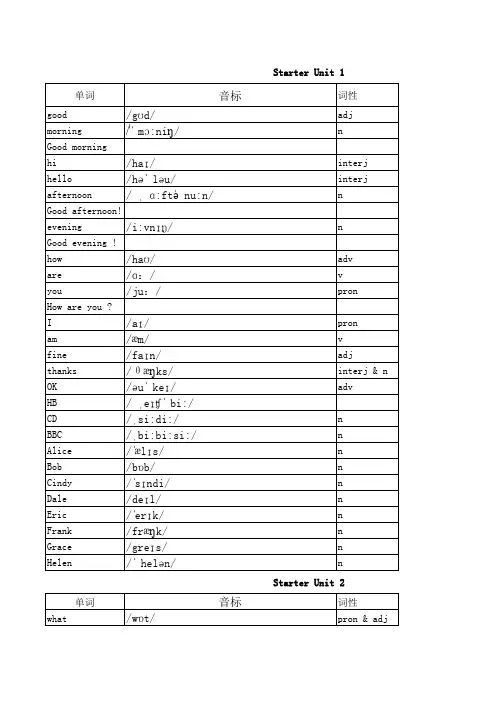
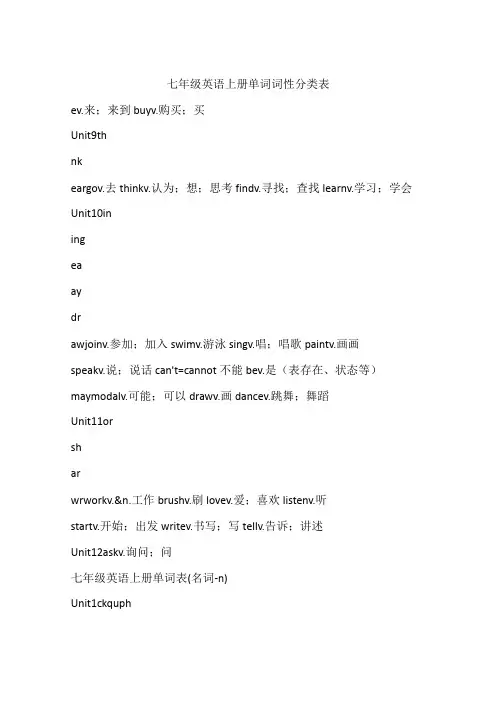
七年级英语上册单词词性分类表ev.来;来到buyv.购买;买Unit9thnkeargov.去thinkv.认为;想;思考findv.寻找;查找learnv.学习;学会Unit10iningeaaydrawjoinv.参加;加入swimv.游泳singv.唱;唱歌paintv.画画speakv.说;说话can't=cannot不能bev.是(表存在、状态等)maymodalv.可能;可以drawv.画dancev.跳舞;舞蹈Unit11orsharwrworkv.&n.工作brushv.刷lovev.爱;喜欢listenv.听startv.开始;出发writev.书写;写tellv.告诉;讲述Unit12askv.询问;问七年级英语上册单词表(名词-n)Unit1ckquphtionlyeroyarirnamen.名字clockn.钟questionn.问题;难题;询问;疑问answern.回答;答复;答案boyn.男孩girln.女孩phonen.电话telephonen.电话numbern.数;数字familyn.家;家庭cardn.卡;卡片name's=nameis名字是Unit2ooercktionaryshaltchcomcheyingpenciln.铅笔penn.钢笔bookn.书erasern.橡皮;铅笔擦;黑板擦rulern.尺;直尺casen.箱;盒;橱backpackn.双肩背包dictionaryn.字典;词典Englishn.英语;英文baseballn.棒球watchn.手表computern.电脑;电子计算机gamen.游戏schooln.学校keyn.钥匙notebookn.笔记本ringn.环;戒指Unit3erthareouaughunturephsistern.姐;妹mothern.妈妈;母亲fathern.爸爸;父亲parentn.父亲或母亲brothern.兄;弟grandmothern.祖母;外祖母grandfathern.祖父;外祖父friendn.朋友grandparentn.祖父(母);外祖父(母)auntn.姨母;姑母;伯母;婶母;舅母sonn.儿子cousinn.堂(表)兄弟;堂(表)姐妹daughtern.女儿unclen.叔;伯;舅;姨夫;姑父picturen.照片;图片photon.照片;相片Unit4bledreroochairawtheothingoortablen.桌子bedn.床dressern.梳妆台bookcasen.书橱;书柜sofan.沙发chairn.椅子drawern.抽屉plantn.植物bagn.书包;提包;袋子mathn.数学CDabbr.光盘videon.录像;视频tapen.录音带hatn.帽子thingn.东西;物momn.妈妈(非正式用语)floorn.地板;地面roomn.房间TVabbr.电视;电视机deskn.书桌;课桌Unit5eralckeyoraytionsoccern.英式足球balln.球tennisn.网球racketn.球拍(网球、羽毛球的)ping-pongn.乒乓球volleyballn.排球basketballn.篮球batn.球拍(乒乓球等的)sportn.运动clubn.社团;俱乐部classn.班级;(一节)课dayn.天;日间;白天;一日collectionn.收藏品;收集物Unit6urerorpleeaoochckeauitraweararblebananan.香蕉hamburgern.汉堡包tomaton.西红柿broccolin.花椰菜orangen.橙子icen.冰applen.苹果creamn.奶油;乳脂foodn.食物eggn.蛋;鸡蛋carrotn.胡萝卜chickenn.鸡;鸡肉breakfastn.早餐lunchn.午餐dinnern.晚餐;正餐fruitn.水果saladn.沙拉strawberryn.草莓pearn.清单starn.星星;明星vegetablen.蔬菜;植物runnern.奔跑者梨dessertn.(饭后的)甜食listn.清单Units1-6contionurtureeoplenkblankn.空白conversationn.交谈;谈话furnituren.家具(总称)peoplen.人;人民七年级英语上册单词表(名词-n)Unit7tsckshiroreaerarskwheeowexplethorepantsn.(pl.)裤子sockn.短袜shirtn.男衬衣;衬衫T-shirtn.T恤衫shortsn.(pl.)短裤sweatern.毛衣shoen.鞋skirtn.裙子salen.出售;廉价销售dollarn.元(美国、加拿大等国的货币单位,符号为$)colorn.色;颜色blackadj.&n.黑色(的)whiteadj.&n.白色(的)redadj.&n.红色(的)greenadj.&n.绿色(的)blueadj.&n.蓝色(的)yellowadj.&n.黄色(的)clerkn.(银行、办公室、商店等的)职员;办事员examplen.例子;实例pricen.价格clothesn.(pl.)衣服;服装storen.商店Mrn.先生(冠于男子之姓或姓名之前的称呼)Unit8irthayaryarchlyauereechcontytraralearbirthdayn.生日monthn.月月份Januaryn.一月;正月Februaryn.二月Marchn.三月Apriln.四月Mayn.五月Junen.六月Julyn.七月Augustn.八月Septempern.九月Octobern.十月Novembern.十一月Decembern.十二月daten.日期birthn.出生;出世;诞生agen.年龄;年纪speechn.演说;讲演;说话;言论contestn.竞赛;比赛partyn.聚会;晚会tripn.旅途;观光旅行(常指短程)artn.艺术;美术;艺术品festivaln.(音乐、芭蕾舞、戏剧性等之)节;节日Chinesen.&adj.中文;中国人musicn.音乐yearn.年Unit9mentarytherindingarurereeoryormovien.電影comedyn.喜劇documentaryn.記錄片thrillern.恐怖電影或小說kindn.種類singularn.&adj.單數;單數形式;單數的pluraln.&adj.複數;複數形式;複數的operan.歌劇weekendn.週末historyn.歷史actorn.演員studentn.學生Unit10uiarckshowayciandrtrchaiguitarn.吉kidn.小孩;年轻人rockn.摇滚乐bandn.乐队shown.&v.n.演出;表演;v.展示;给……看Sundayn.星期日;星期天pmabbr.(或p.m.)下午musiciann.音乐家;擅长音乐的人drumn.鼓pianon.钢琴trumpetn.喇叭violinn.小提琴chessn.国际象棋e-mailn.(或email)电子邮件addressn.通讯处;地址Unit11showeroroureeoothghingurayeytimen.时间showern.淋浴;淋浴器workv.&n.工作hourn.小时teethn.(tooth的复数形式)牙齿busn.公共汽车hoteln.旅馆nightn.夜;夜间morningn.早晨;上午afternoonn.下午;午后eveningn.傍晚;黄昏;晚上jobn.工作;零工;任务;职位amabbr.(或a.m.)上午homeworkn.家庭作业;课外作业wishn.希望;祝愿Saturdayn.星期六surveyn.调查;考察lettern.信Unit12Tionoreacherartyaysubjectn.学科;科目sciencen.科学descriptionn 描述;记述wordn.字;词;话teachern.教师partnern.伙伴;合作者Mrs夫人;太太(冠于已婚妇女之姓或姓名之前的称呼)cityn.城市dadn.(非正式用语)爸爸Tuesdayn.星期二Thursdayn.星期四Wednesdayn.星期三Fridayn.星期五Mondayn.星期一biologyn.生物学dogn.狗Miss 小姐(冠于未婚妇妇之姓或姓名之前的称呼)Units7-12Aychhobbyn.业余爱好todayn.&adv.今天;今日lifen.生活Chinan.中国American.美国;美洲七年级英语上册单词表(形容词-adj)Unit1irniceadj.好的;令人愉快的firstadj.第一的lastadj.最后的;上一个的Unit2ththispron.&adj.这;这个thatpron.&adj.那;那个Unit3thearthesepron.&adj.这些thosepron.&adj.那些dearadj.亲爱的(冠于信函中的称谓,以示礼貌)Unit4someadj.&pron.一些;若干Unit5oooreereingoreagoodadj.良好的;令人满意的manyadj.大量的moreadj.更多的;更大的interestingadj.有趣的令人感兴趣的boringadj.无聊的;令人生厌的funadj.令人愉快的difficultadj.困难的relaxingadj.轻松的greatadj.美妙的;大的everyadj.每一;每个Unit6eathhealthyadj.健康的;强健的Units1-6therotherpron.&adj.另外的人(物);其他的Unit7Ckwheeowalshorngblackadj.&n.黑色(的)whiteadj.&n.白色(的)redadj.&n.红色(的)greenadj.&n.绿色(的)blueadj.&n.蓝色(的)yellowadj.&n.黄色(的)bigadj.广大的;重大的smalladj.小的;小号的shortadj.短的;矮的longadj.长的welcomeadj.不必客气的sorryadj.抱歉的;遗憾的;难过的Unit8oldoldadj.年岁的;年老的;年长的happyadj.愉快的;高兴的;满意的Unit9aryexingewfulfavoriteadj.&n.最喜爱的scaryadj.可怕的;吓人的funnyadj.有趣的;好玩的sadadj.悲哀的;悲伤的excitingadj.令人激动的;振奋人心的newadj.新的successfuladj.成功的Unit11oobestadj.&adv.(good,well的最高级)最好的(地)Unit12trbusyadj.忙的;繁忙的;忙碌的strictadj.严格的;严厉的tiredadj.疲倦的;累的七年级英语上册单词表(副词-adv)Unit2owyesadv.(表示肯定)是noadv.(表示否定)不;不是notadv.(构成否定形式)不是howadv.(指程度)多么;何等;怎样Unit3erehereadv.这里;在这里Unit4wherewhereadv.在哪里(疑问副词)where's=whereis在哪儿Unit5iyonlyadv.只;仅仅Unit6alwelladv.好;对;满意地lotadv.许多;很多alsoadv.也;亦;并且Unit7veryadv.很;非常;颇Unit8whwhenadv.(疑问副词)什么时候;何时Unit9ealyooreallyadv.事实上;无疑地;真正地oftenadv.时常;常常tooadv.也;又;太Unit10thwhthenadv.那时;然后whyadv.(疑问副词)为什么Unit11lyckooouusuallyadv.通常o'clockadv.(只用于正点)……点钟homeadv.家soonadv.不久bestadj.&adv.(good,well的最高级)最好的(地)aroundadv.大约Unit12ounextadv.然后;接下去aroundadv.在附近;到处七年级英语上册单词表(介词-prep)Unit2ininprep.用(表示方法,媒介,工具等)atprep.在…(里面或附近)在…(点、刻);以inprep.在……里面ofprep.(属于)……Unit3orforprep.为了(表示目的或原因)Unit4erunderprep.在……下onprep.在……上toprep.朝;向;至;达Unit7fromprep.从;从……起Unit9outhaboutprep.关于;涉及;在……方面withprep.与……一起;和;使用……(工具);有;附有Unit11erafterprep.&conj.在……之后Unit12orebeforeprep.&conj.在……以前七年级英语上册单词表(连词-conj)Unit1andconj.和;又;而且Unit5butconj.但是Unit10ororconj.或者Unit11eroreafterprep.&conj.在……之后beforeprep.&conj.在……以前Unit12aubecauseconj.因为soconj.因而;所以;那么七年级英语上册单词表(感叹词-interj)Unit1hellointerj.(表示问候)喂hiinterj.(表示问候)嗨Unit2eaOKinterj.好;不错pleaseinterj.(祈使句中用作请求的客套话)请Unit5wellinterj.喔;噢;唔;这个Unit6ohinterj.啊;噢;呀(表示惊讶等)七年级英语上册单词表(代词-pron)Unit1whourerIpron.我mypron.我的youpron.你,你们whatpron.&adj.什么what's=whatis是什么yourpron.你的;你们的hispron.他的herpron.她的itpron.它it's=itis它是Unit2ththispron.&adj.这;这个thatpron.&adj.那;那个I'm=Iam我是Unit3thshthosepron.&adj.那些that's那是thesepron.&adj.这些shepron.她hepron.他he's=heis他是Unit4ththeypron.他们they're=theyare他们是someadj.&pron.一些;若干Unit5orethuspron.我们(we的宾格wepron.我们morepron.更多;更大thempron.(they的宾格)他(她,它)们Unit6therotherpron.&adj.另外的人(物);其他的Unit7eachoureachpron.每个anybodypron.任何人ourpron.我们的yourselfpron.你自己(反身代词)Unit9whsomeonepron.某人whopron.……的人Unit10ourlittlepron.少许;少量alittle少许;少量ourpron.我们的Unit11alallpron.全部;全体mepron.我(I的宾格)Unit12whwhopron.(疑问代词)谁anypron.任何一个(或一些)七年级英语上册单词表(数词-num)Unit1twtheeourghzeronum.零onenum.一twonum.二threenum.三fournum.四fivenum.五sixnum.六sevennum.七eightnum.八ninenum.九Unit7teenirourghtythtennum.十elevennum.十一twelvenum.十二thirteennum.十三fourteennum.十四fifteennum.十五sixteennum.十六seventeennum.十七eighteennum.十八nineteennum.十九twentynum.二十thirtynum.三十Unit8irthourghtwfirstnum.第一secondnum.第二thirdnum.第三fourthnum.第四fifthnum.第五sixthnum.第六seventhnum.第七eighthnum.第八ninthnum.第九tenthnum.第十eleventhnum.第十一twelfthnum.第十二thirteenthnum.第十三fourteenthnum.第十四fifteenthnum.第十五sixteenthnum.第十六seventeenthnum.第十七eighteenthnum.第十八nineteenthnum.第十九twentiethnum.第二十thirtiethnum.第三十七年级英语上册单词表(冠词-art)Unit2ththeart.表示特指的人、物、事或群体aart.一个(只,把,台……)Units1-6anart.(元音前)一个(只,把,台……)七年级英语上册单词表(短语-phrase)Unit1firstname名字lastname姓氏telephonenumber电话号码phonenumber电话号码IDcard身份证familyname姓氏Unit2pencilcase铅笔盒;文具盒pencilsharpener卷笔刀;铅笔刀excuseme请原谅(客套语,用于与陌生人搭话、打断别人说话等场合)computergame电子游戏lostandfound失物招领asetof一套;一副Unit3thanksfor为……而感谢Unit4alarmclock闹钟videotape录像带Unit5soccerball英式足球tennisracket网球拍watchTV看电视playsports参加体育运动或比赛Unit6Frenchfries炸马铃薯条;薯条icecream冰淇淋countablenoun可数名词uncountablenoun不可数名词lotsof大量;许多Unit7howmuch(价钱)多少Hereyouare.给你。
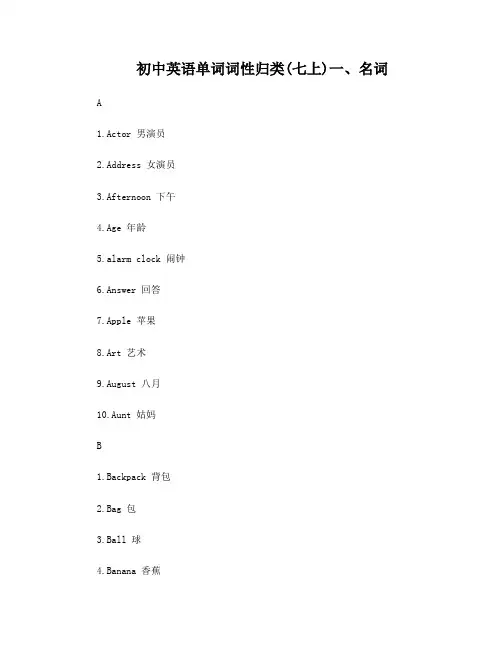
初中英语单词词性归类(七上)一、名词A1.Actor 男演员2.Address 女演员3.Afternoon 下午4.Age 年龄5.alarm clock 闹钟6.Answer 回答7.Apple 苹果8.Art 艺术9.August 八月10.Aunt 姑妈B1.Backpack 背包2.Bag 包3.Ball 球4.Banana 香蕉5.Band 乐队6.Baseball 棒球7.Basketball 篮球8.Bat 蝙蝠9.Bed 床10.Biology 生物学11.Birth 出生12.Birthday 生日13.Blank 空白14.Book 书15.Bookcase 书柜16.Boy 男孩17.Breakfast 早餐18.Bring 带来19.Broccoli 西兰花20.Brother 哥哥21.Bus 公共汽车C1.Card 卡片2.Carrot 胡萝卜3.Case 情况4.CD 光盘5.Chair 椅子6.Chess 国际象棋7.Chicken 鸡8.China 中国9.City 城市10.Class 班级11.Clerk 职员12.Clock 时钟13.Clothes 衣服14.Club 俱乐部15.Collection 收集16.Color 颜色edy 喜剧puter 电脑19.Contest 比赛20.Conversation 谈话21.Cousin 表弟22.Cream 奶油D1.Dad 爸爸2.Date 日期3.Daughter 女儿4.Day 一天5.December 十二月6.Description 描述7.Desk 桌子8.Dessert 甜点9.Dictionary 字典10.Dinner 晚餐11.Documentary 纪录片12.Dog 狗13.Dollar 美元14.Drawer 抽屉15.Dresser 梳妆台16.Drum 鼓E1.Egg 蛋2.e-mail 电子邮件3.English 英语4.Eraser 橡皮擦5.Evening 晚上6.Example 例子7.Family 家庭8.Father 父亲9.February 二月10.Festival 节日11.Floor 地板12.Food 食物13.Fries 炸薯条14.Friday 星期五15.Friend 朋友16.Fruit 水果17.Furniture 家具18.Game 游戏19.Girl 女孩20.Grandfather 祖父21.Grandmother 祖母22.Guitar 吉他23.Hamburger 汉堡24.Hat 帽子25.History 历史26.Hobby 爱好27.Homework 家庭作业28.Hotel 酒店29.Ice 冰30.ice cream 冰淇淋J1.January 一月2.Job 工作3.June 六月4.July 七月K1.Key 关键2.Kid 孩子3.Kind 类L1.Letter 信2.Life3.list4.lunchM1.March2.math3.May4.mom5.Monday6.month7.morning8.mother9.movie10.music N2.night3.notebook4.number5.November O1.OctoberP1.pants2.parent3.partner4.party5.pear6.pen7.pencil8.people9.phone10.photo11.pencil case12.pencil sharpener13.piano14.picture15.ping-pong16.plant17.plural18.priceR1.racket2.ring3.rock4.room5.ruler6.runnerS1.salad2.sale3.Saturday4.school5.science6.September7.shirt8.shoe9.shorts10.show11.shower12.singular13.sister14.skirt15.soccer16.sock17.sofa18.son19.sport20.speech21.star22.store23.strawberry24.student25.subject26.Sunday27.survey28.sweaterT1.table2.tape3.teacher4.teeth5.telephone6.telephone number7.tennis8.thing9.thriller 10.time11.today12.tomato13.trip14.trumpet15.T-shirt16.TuesdayU1.uncleV1.vegetable2.video3.video tape4.violin5.volleyball6.volleyball game W1.watch2.Wednesday3.weekend4.wish5.word6.workY1.year二、形容词B1.best2.big3.black4.blue5.boring6.busyD1.dear2.difficultE1.every2.excitingF1.favorite2.first3.fun(funny) G1.good2.great3.greenH1.happy2.healthyLst2.longM1.manyN1.new2.niceO1.oldR1.red2.relaxingS1.sad2.scary3.short4.small5.some6.sorry7.strict8.successful T1.that2.these3.this4.tired5.those WA1.welcome2.white3.yellow三、动词1.am2.afford3.are4.askB1.be2.bring3.brush4.buyC1.calleD1.draw2.dance3.dose4.doE1.eat2.excuse F1.find2.found G1.goH1.has2.have3.help I 1.isJ1.join K 1.know L1.learn2.let3.like4.listen5.look6.lost7.love M 1.meet N 1.need P 1.paint2.play S1.see2.sell3.sing4.show5.sound6.speak7.spell8.start 9.swim T1.take2.tell3.thank4.think W1.want2.watch3.work4.write四、副词A1.alsoB1.BestH1.here2.home3.how L1.lot N1.next2.no3.not O1.o’clock2.often3.onlyR1.really S 1.soonT1.then2.today3.tooUually V 1.very W1.well2.when3.where4.whyY1.yes五、冠词1. a2.an3.the六、介词1.about2.at3.after4.before5.for6.in7.of8.on9.under10.with11.from12.to七、代词1.all2.any3.some4.anybody5.anyone6.both7.something8.anything9.nothing10.each11.he12.himself13.her14.hers15.herself16.his17.I18.it19.little20.me21.more22.my23.mine24.our25.ours26.we28.other29.myself30.ourselves31.she32.someone33.that34.them35.these36.they37.themselves38.this39.those40.what41.who42.you43.your44.yours45.yourself八、连词1.after2.and3.because4.but5.or。
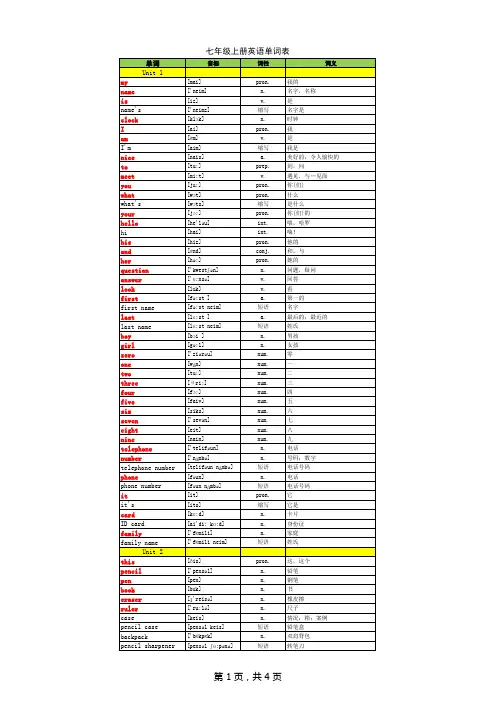

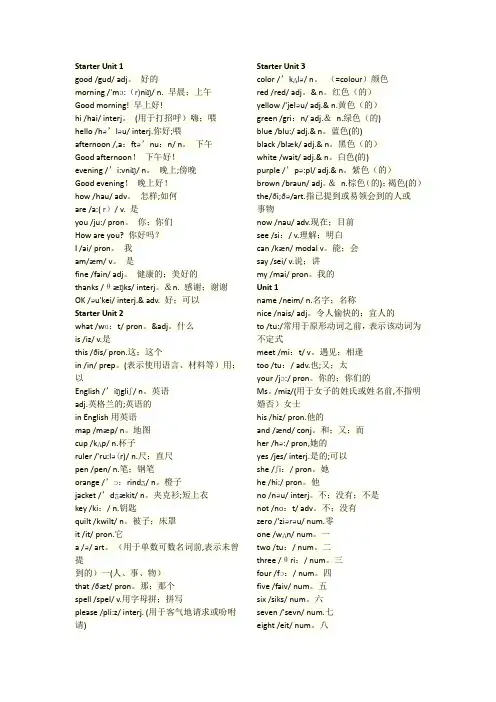
Starter Unit 1good /gud/ adj。
好的morning /'mɔ:(r)niŋ/ n. 早晨;上午Good morning! 早上好!hi /hai/ interj。
(用于打招呼)嗨;喂hello /hə’ləu/ interj.你好;喂afternoon /,a:ftə’nu:n/ n。
下午Good afternoon!下午好!evening /’i:vniŋ/ n。
晚上;傍晚Good evening!晚上好!how /hau/ adv。
怎样;如何are /a:( r)/ v. 是you /ju:/ pron。
你;你们How are you? 你好吗?I /ai/ pron。
我am/æm/ v。
是fine /fain/ adj。
健康的;美好的thanks /θæŋks/ interj。
&n. 感谢;谢谢OK /əu'kei/ interj.& adv. 好;可以Starter Unit 2what /wɑ:t/ pron。
&adj。
什么is /iz/ v.是this /ðis/ pron.这;这个in /in/ prep。
(表示使用语言、材料等)用;以English /’iŋgliʃ/ n。
英语adj.英格兰的;英语的in English用英语map /mæp/ n。
地图cup /kʌp/ n.杯子ruler /'ru:lə(r)/ n.尺;直尺pen /pen/ n.笔;钢笔orange /’ɔ:rindʒ/ n。
橙子jacket /’dʒækit/ n。
夹克衫;短上衣key /ki:/ n.钥匙quilt /kwilt/ n。
被子;床罩it /it/ pron.它a /ə/ art。
(用于单数可数名词前,表示未曾提到的)一(人、事、物)that /ðæt/ pron。
名词(n.)1.时刻表2.显示器3.周五4.非洲5.种类6.周末7.旅行8.周一9.键盘10.鼠标11.打印机12.文件13.方框14.伦敦15.长颈鹿16.网站17.笔记本18.大象19.网络20.周六21.孙子\女22.火车23.印度24.姥姥25.蛇26.叶子27.牛奶28.家务劳动29.日子,白天30.世界31.草原32.草33.价格34.丛林35.计划36.森林37.图书馆38.沙漠39.操场40.乒乓球41.大洋洲42.美洲43.科目44.动物园45.老虎46.实验室47.周四48.狮子49.竹子50.澳大利亚51.斑马52.艺术53.T恤54.动物55.导游56.参观,访问57.狼58.熊猫59.主意60.牛仔裤61.软运动鞋62.双;对63.袋鼠64.亚洲65.杂志66.小说67.北极68.欧洲69.音乐会70.习惯71.周日72.卡片73.骆驼74.音乐75.歌手76.衣服77.钢琴78.光盘79.字典80.……岁81.衬衫82.黑板83.丝绸84.饭店85.盒子86.礼物87.工厂88.票89.公园90.表演91.晚饭;正餐92.午饭93.地点94.科学95.课间休息96.图片;照片97.房子98.剧院99.游泳100.周二101.游戏102.时间103.一半104.化学105.历史106.数学107.早饭108.晚会109.生日110.桌子111.晚上112.巧克力113.邀请114.猴子115.魔术116.周三117.队伍118.工人119.明星120.比赛121.体育馆122.电影123.电影院124.英语125.一节课126.班级127.学生128.女士129.城市130.英国131.工厂132.父;母133.篮球134.马135.外祖父\母136.家庭137.照片138.网球139.秘书140.经理141.医生142.办公室143.医院144.大学145.饭厅;饭堂146.体育馆147.一个物;一个人148.建筑物149.人们;人150.姑母151.外祖父152.祖母153.姨父154.冰箱155.冰激凌156.汉堡包157.可口可乐158.姐,妹159.姥爷160.电子邮件161.橘子162.饮料163.水果164.蔬菜165.牛肉166.胡萝卜167.鸡肉168.洋葱169.猪肉170.果汁171.甜瓜172.土豆173.西红柿174.面条175.糖果动词(v.)1.下载2.检查3.打印4.连接5.用开关把…开启6.使用7.点击8.保存;挽救9.参观;访问10.想,认为11.选择,挑选12.发送13.得到14.结束15.来16.停留17.谈论18.开始19.吃20.邀请21.询问,问22.让23.生活,住24.喝25.做,制作26.拥有27.练习28.打开29.关闭30.相称,匹配31.遇见32.写33.骑;开车34.欢迎形容词(adj.)1.在线2.大洋洲的3.美洲的4.非洲的5.欧洲的6.亚洲的7.澳大利亚的8.更多9.每一个10.不同的11.进行;上演12.刚刚过去的,最近的13.伟大的14.不健康的15.最喜欢的16.健康的17.许多18.一些19.正确的20.国际的21.第一22.英国的副词(adv.)1.有时候;不时2.在线3.再一次;又4.然后5.然后,其次6.首先7.最后8.首先9.在这里10.从不11.经常12.通常13.总是,一直14.……点钟15.今天16.什么时候,何时17.进行,上演18.也数词(num.)1.十二2.十三3.十四4.十一5.二十九6.五十7.四十六8.十五9.十六10.十七11.十八12.十九13.三十14.六十15.七十16.八十17.九十18.千代词(pron.)1.她的2.用于引导句子3.任何一个4.他宾格5.他/她/他们宾格介词(prep.)1.在工作和学习地点2.在……前面3.在……旁边4.在……后面5.和……一起6.超过7.关于8.在某事件或时刻9.通过,以……方式连词(conj.)1.或者2.但是助动词(aux.)1.能够2.愿意感叹词(inj.)1.好的短语1.让我们2.……怎么样?3.大量,许多4.一双,一对5.想出名词animal English idea elephant invitation artaunt uncle office email orange onion evening Internetclass grandchild mouse leafzoo photo boxwolf giraffe monkey kangaroo dictionary party library family secretary university city history potato tomato match website londonpictureweekendlaptoptimetabletraintravelkindkeyboardprintermonitorcomputerdocumentworldIndiagrasslanddesertforestjungleAmericaOceaniaAfricazebraEuropeAustraliaArcticAsiaguidetriptigercamellionpolar bearsnakepandasingerclothesCDmagazineshirtT-shirtpairtrainerboxnoveljeansticketpresentcardhabitparkbirthdaytablechocolatecinemafilmstadiumstarteamFridayMondaySaturdaySundayThursdayTuesdayWednesdayplaygrounddinnerlunchbreakhouseo’clockbreakfastmagicshowdayplacepricetheatremomentswimmingplangamesistergrandmagrandpadrinkvegetablemelonnoodlehamburgerfridgecarrotgrandparentsgrandmothergrandfatherpeoplebuildingonesciencegym(gymnasium)dining halllab(laboratory)televisionworkerdoctormanagerhorsetennispianobasketballtable tennisfactoryhotelhospitallessonstudentMissEnglandparentblackboard information chicken milkbeef candy Cokeice cream bamboo housework fruitjuiceporktime music grasssilk动词meet close practise finishcanride welcome have make drinklive wouldletinviteaskcomestaytalkstartgetsend thinkvisitprintswitchconnetclicksavecheck形容词firstEnglishinternationalrightsomemanyhealthyunhealthylastyounggreatondifferenteveryEuropeanAsianmoreAfricanAmericanOceanian副词tootodayalwaysusuallyherefinallyfirstnextthensometimes介词frombehindwithaboutpastaton代词hertherehimthemits连词or感叹词OK数词twelvethirteenfourteeneleventwenty-ninefiftyforty-sixfifteensixteenseventeennineteentwentythirtysixtyseventyeithtyninetythousand短语have gotlet’sWhat about—go homeget upa pair oflots of a lot ofthink ofswitch on固定用法e2.ask3.like4.enjoy5.would like6.let7.finish8.practise9.invite10.What about11.get12.send13.can。
Starter Unit 1good /gud/ adj。
好的morning /'mɔ:(r)niŋ/ n. 早晨;上午Good morning!早上好!hi /hai/ interj. (用于打招呼)嗨;喂hello /hə’ləu/ interj.你好;喂afternoon /,a:ftə'nu:n/ n. 下午Good afternoon! 下午好!evening /’i:vniŋ/ n。
晚上;傍晚Good evening! 晚上好!how /hau/ adv. 怎样;如何are /a:( r)/ v. 是you /ju:/ pron。
你;你们How are you? 你好吗?I /ai/ pron。
我am/æm/ v。
是fine /fain/ adj。
健康的;美好的thanks /θæŋks/ interj.&n. 感谢;谢谢OK /əu'kei/ interj。
& adv。
好;可以Starter Unit 2what /wɑ:t/ pron。
&adj.什么is /iz/ v.是this /ðis/ pron.这;这个in /in/ prep。
(表示使用语言、材料等)用;以English /'iŋgliʃ/ n.英语adj。
英格兰的;英语的in English用英语map /mæp/ n.地图cup /kʌp/ n。
杯子ruler /'ru:lə(r)/ n.尺;直尺pen /pen/ n。
笔;钢笔orange /’ɔ:rindʒ/ n.橙子jacket /'dʒækit/ n.夹克衫;短上衣key /ki:/ n.钥匙quilt /kwilt/ n。
被子;床罩it /it/ pron。
它a /ə/ art。
(用于单数可数名词前,表示未曾提到的)一(人、事、物)that /ðæt/ pron.那;那个spell /spel/ v。
Starter Unit 1good /gud/ adj. 好的morning /’mɔ:(r)niŋ/ n。
早晨;上午Good morning! 早上好!hi /hai/ interj。
(用于打招呼)嗨;喂hello /hə’ləu/ interj。
你好;喂afternoon /,a:ftə'nu:n/ n. 下午Good afternoon! 下午好!evening /’i:vniŋ/ n. 晚上;傍晚Good evening! 晚上好!how /hau/ adv. 怎样;如何are /a:( r)/ v。
是you /ju:/ pron. 你;你们How are you? 你好吗?I /ai/ pron。
我am/æm/ v。
是fine /fain/ adj. 健康的;美好的thanks /θæŋks/ interj.&n. 感谢;谢谢OK /əu’kei/ interj.&adv. 好;可以Starter Unit 2what /wɑ:t/ pron。
&adj。
什么is /iz/ v。
是this /ðis/ pron。
这;这个in /in/ prep.(表示使用语言、材料等)用;以English /’iŋgliʃ/ n.英语adj。
英格兰的;英语的in English用英语map /mæp/ n。
地图cup /kʌp/ n。
杯子ruler /’ru:lə(r)/ n。
尺;直尺pen /pen/ n。
笔;钢笔orange /'ɔ:rindʒ/ n。
橙子jacket /'dʒækit/ n。
夹克衫;短上衣key /ki:/ n.钥匙quilt /kwilt/ n.被子;床罩it /it/ pron.它a /ə/ art。
(用于单数可数名词前,表示未曾提到的)一(人、事、物)that /ðæt/ pron.那;那个spell /spel/ v。
Documents from the network, it is my collection arrangement, if there are any omissions, errors, please correct me!Master's degree graduate studentsPolitical theory exam outlineThe first part: marxismThe introduction of marxism is the science of proletarian and human liberationThe first section the emergence and development of marxismThe meaning of marxism; The economic and social cause of marxism, ideological origin and practice foundation; The creation of marxismThe unity of marxist scientific and revolutionary in the second quarterThe marxist world outlook and methodology, politics, the theory of quality, and social idealsThe first chapter material and its law of development of the worldThe first section in the material world and practiceMaterialism and idealism, knowability and agnosticism, dialectics and metaphysics; The establishment of marxist philosophy in the great change in the history of philosophy; Marxist view of matter and its theoretical significance; The origin of consciousness and nature; Material world unity; The basic features of practice and basic form; Practice essence of social lifeDevelopment and things of widespread contact in the second quarterWidespread contact of the principle of methodology; The essence of the development; Contradiction and identity and struggle; The meaning of the contradictory relationship between universality and particularity principle; Things in the development of quantitative change and qualitative change, and their dialectical relationship; Dialectical negation view and the methodology significanceObjective regularity and subjective initiative of the 3rd quarterLaw and objectivity; The performance of the consciousness of active functions; Subjectiveinitiative and objective regularity of the relationship; Social and historical trend and the relationship between the subject choiceThe second chapter to know the world and transform the worldThe first section essence and regularity of understandingThe relationship and interaction process of subject and object. Practice decisive effect to know; The guiding role of theory to practice, The essence of knowledge; Repeatability in the process of cognition and limitless; The unity of knowledge and practice of specific historyTruth and value in the second quarterTruth and objectivity; The absoluteness and relativity of truth and their dialectical relationship; The practice of the criterion for testing truth; Practice the truth of the scale and value scale; Value and characteristics; Truth and value of dialectical unification relationsThe third chapter of human society and its law of developmentThe first section social basic contradiction and motionThe principle of social existence and social consciousness of the dialectical relationship between theory of meaning; The principle of productivity and production relations contradictory movement rule of theoretical significance and practical significance; The contradiction between economic basis and superstructure contradiction interaction motion; The replacement of social formation of unity and diversity; The necessity of social form change with people's historical selectivityIn the second quarter. The power of the development of society and historyThe role of social basic contradiction in social development; The meaning and role of class struggle; Revolutionary effect on the development of the society; The nature and function of reform; The role of science and technology revolutionThe role of the third quarter of the people in the historical developmentThe reality person and its activity and the social history; The essence of man. Determining the masses of the people in the process of history; The mass viewpoint and the mass line; The role of historical figures in historical developmentThe fourth chapter the formation of capitalism and its natureThe formation of the capitalism in section 1 and is based on private ownership of commodity economyThe formation of the capitalist mode of production; The two factors and production of goods commodity labor duality; The decision of the commodity value; Law of value and function; Theoretical and practical significance of Marx's labor theory of valueThe nature of the capitalist economic system in the second quarterThe meaning of the surplus value; The nature of capital; Surplus value rate; The nature of capital accumulation; Historical trends of capital accumulation; Capital turnover; The core issue of social reproduction. Profits and average profit; The significance of Marx's theory of surplus value. The basic contradiction of capitalism and its deepeningChapter v of the historical process of capitalist developmentIn the first quarter from the free competition capitalism to monopoly capitalismThe two stages of the development of capitalism. The formation of monopolies and nature; Financial capital and financial oligarchs; Monopoly profits and monopoly pricing; The formation of state monopoly capitalism, form and function; The essence of monopoly capitalism; Economic globalization and its performanceThe contemporary capitalist new change in the second quarterChanges of the private ownership of the means of production; The change of relations between labor relations and distribution; Social class, class structure changes; Changes in the form of economic regulation mechanism and the economic crisis; The change of political system; The contemporary capitalist new change reasons and essenceThe third section, the history status and trend of development of capitalismThe history of capitalism; Capitalism to socialism replaced historical inevitability; The transition from capitalism to socialism is a long historical processThe sixth chapter of socialist society and its developmentThe first section of the socialist system establishedThe establishment of the scientific socialism; The characteristics of the proletarian revolution; The Soviet model; The socialist system of the tremendous contribution to the development of human history; The dictatorship of the proletariat and socialist democracyIn the second quarter of socialist development and improvement in practiceThe basic features of socialist; Task of socialist construction and long-term; The diversity of the socialist development path; The unity of the development of forward twists; The reform of socialismThe third section of marxist political party in the position and role of the socialist causeOf marxist political party and nature; The basic aim of marxist parties and organizations principle; Marxist political party in the revolutionary struggle and socialist construction in the process of leading role; To improve the leadership of the partyThe second part: the sinicization of marxismThe introduction of sinicization of marxism history and theoretical resultsThe first section the scientific connotation of marxism and its historical processSinicization of marxism is put forward; Scientific connotation of sinicization of marxism; The historical process of marxism and of great significanceMAO zedong thought in the second quarterThe formation and development of MAO zedong thought; A scientific system of MAO zedongthought and main content; The historical position of MAO zedong thought and guiding significanceDeng xiaoping's theory of the 3rd quarterThe formation and development of deng xiaoping theory; The scientific system of deng xiaoping theory and the main content; The historical position of deng xiaoping theory and guiding significanceThe fourth quarter, "the three represents" important thoughtA scientific system of "three represents" important thought and main content; "The three represents" the important thoughts of the historical status and guiding significanceSection 5 the concept of scientific developmentThe formation of the scientific outlook on development; The main content of the scientific outlook on development; The guiding significance of the scientific concept of developmentThe first chapter is the essence of marxism theory resultsThe first section of the formation and development of the ideological line of seeking truth from factsThe formation and establishment of ideological line of seeking truth from facts; The ideological line of seeking truth from facts to establish and developThe content of the ideological line of seeking truth from facts and meaning in the second quarter The basic content of ideological line of seeking truth from facts; The significance of the ideological line of seeking truth from factsIn the third quarter to emancipate the mind, seeking truth from facts and advancing with The TimesSeeking truth from facts is the essence of marxism theory achievements; Emancipating the mind is a magic weapon to the development of socialism with Chinese characteristics; Constantly bring forth theoretical innovationThe second chapter new-democratic revolution theoryThe first section the formation of new democratic revolution theoryModern China's national conditions and the era characteristics of the Chinese revolution; The formation and development of new democratic revolution theory; The meaning of the new democratic revolution theoryGeneral line and basic program of new democratic revolution in the second quarterNew-democratic revolution of the general line is put forward; The nature of the new-democratic revolution and the future; New-democratic revolution of politics, economy and cultural programmeThe third section of the new-democratic revolution road and basic experienceThe main content of the Chinese revolution road theory and its meaning; New-democratic revolution road; New-democratic revolution of the three big magic weapon and their mutual relations; The establishment of the revolutionary united front and its main experience; The armed struggle is the main form of struggle of the Chinese revolutionThe third chapter socialist transformation theoryThe first section transition from new democracy to socialismThe nature of the new democratic society and characteristics; General line of transition period and the basic contentSocialist transformation road and the historical experience in the second quarterSocialist transformation of agriculture, handicraft industry; The capitalist industry and commerce socialist transformation; Historical experience of socialist transformationThe third quarter, the establishment of the socialist system in ChinaEstablishment socialist basic system in our country; The significance of establishing socialist basic systemThe fourth chapter the essence and fundamental task of socialismThe first section of the road of socialist construction with Chinese characteristicsThe road of socialist construction with Chinese characteristics theoretical achievements of preliminary exploration; The party to the socialism understanding twistsNew understanding of the essence of socialism in the second quarterSocialism essence theory is put forward, scientific connotation and significanceThe third section the fundamental task of socialismDevelopment is the absolute truth. Development is the party's top priority in governing and rejuvenating the country; On behalf of the development of China's advanced productive forces; Science and technology is the first productive forceChapter v of the primary stage of socialism theoryThe first section the primary stage of socialism is the greatest practicalThe formation and development of the theory of socialist primary stage; Scientific meaning and the main characteristic of the primary stage of socialism; The long-term of the primary stage of socialism in our countryIn the second quarter of the primary stage of socialism basic line and programThe primary stage of socialism main contradiction; The primary stage of socialism basic line is put forward and its main content; The basic outline of the primary stage of socialismThe third section of the primary stage of socialism development strategyThe development of the "three steps" strategy; The construction of a well-off society in an all-round wayThe sixth chapter socialist reform and opening to the outside worldSection 1. Reform and opening up is the key to the fate of contemporary ChinaReform and opening up is a new great revolution; The basic contradiction of the socialist societyIn the second quarter unswervingly promote reform in an all-round wayComprehensive reform; Correctly handle the relationship between reform, development and stabilityThe third section unswervingly stick to opening to the outside worldChina's development cannot leave the world; An omni-directional, multilevel and wide-range opening; To improve the level of an open economyChapter 7 building socialist economy with Chinese characteristicsThe first section to establish the socialist market economic systemChina's socialist economic system of the selection process; The formation and development of the socialist market economy theory. The basic characteristics of the socialist market economy systemThe primary stage of socialism basic economic system of the second quarterThe establishment of the primary stage of socialism basic economic system; Adhere to the dominant position of public ownership economy; Encourage, support and guide non-public economic developmentThe third section of the primary stage of socialism distribution systemThe main body status of stick to distribution according to work; Variety of modes of distribution coexist. We will deepen reform of the distribution system; Improve the social security systemChapter 8 of the construction of socialism with Chinese characteristics politicsThe first section democratic politics of socialism with Chinese characteristicsAdhere to the leadership of the party and the people are masters of the country and the unity of the rule of law; The people's democratic dictatorship. The people's congress system; China's system of multi-party cooperation and political consultation under the leadership of the communist party; Regional national autonomy; The grassroots autonomy systemThe rule of law in the second quarter, the build socialism country under the rule of lawThe rule of law is the basic strategy for the party leads the people in the governance of the country To strengthen the construction of socialist legal systemIn the third quarter to promote political restructuring, develop democracy politicsWe will deepen reform of the political system; Expand socialist democracy; Socialist democracy, freedom and human rightsChapter ix construction of socialist culture with Chinese characteristicsThe first section develop advanced socialist cultureAdhere to the direction of socialist advanced culture; The basic task of the construction of socialist culture with Chinese characteristics; The basic principle of the construction of socialist culture with Chinese characteristicsThe construction of socialist core value system in the second quarterThe socialist core value system is the essence of socialist ideology; Adhere to the guiding ideology of marxism; Set up the common ideal of socialism with Chinese characteristics; Carry forward the national spirit and the spirit of the age; Set up the socialism outlook for honor and dishonorIn the third quarter to strengthen ideological and moral construction and education, scientific and cultural constructionStrengthening ideological and moral construction; To strengthen the construction of education science and culture; We will deepen reform of the cultural system and develop cultural undertakings and cultural industriesChapter ten Building a harmonious socialist societyThe first section, the importance and urgency of building a harmonious socialist societyBuilding a socialist harmonious society is put forward; To build the scientific meaning of socialist harmonious society; The significance of building a harmonious socialist societyBuilding a harmonious socialist society in the second quarter of the overall train of thought Building a harmonious socialist society guiding ideology, basic principles and objectives of the task; We will accelerate social development with the focus on improving people's lives????????1。